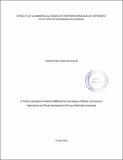Effect of Commercial Feeds on the Performance of Different Ecotypes of Indigenous Chicken

View/
Date
2016-06Author
Murage, Josephine Njeri
Type
ThesisLanguage
enMetadata
Show full item recordAbstract
The experiment was conducted to determine whether plumage colour has any genetic advantage on indigenous chicken (Gallus domesticus) growth rate. Over 70% of indigenous chicken are reared on free-range. Farmers spend very little on feeding, housing and health care leading to high mortality and low growth rate. There is also very little information on the performance of the different indigenous chicken’s ecotypes. The general objective was to determine whether plumage colour has any genetic advantage on indigenous chicken growth rate. The specific objective was to compare the growth rate of different indigenous chicken ecotypes when fed on commercial feeds. The experiment was conducted on Mary Mathenge’s farm in Kirinyaga County. Forty eight KIC day old chicks (DOC) were obtained from KARI Naivasha hatchery. The chicks were black, brown and white ecotypes based on their plumage colour. Sixteen female chicks of each ecotype were used. The experiment was carried out in 3 treatments whereby birds were given 90 g ( FI), 100 g (F2) and 110 g ( F3) of feed and was replicated 3 times. Nine raised floor cages were used. Four birds of the same ecotype were randomly distributed in each cage. Twelve birds, four of each ecotype were left on free-range. Birds’ weight was taken weekly. The results show that weight gain was similar for the 3 ecotypes. There were some significance difference between the birds means weight gain on the different weeks. Birds mean weight gain was highest on the 17th week relative to the other weeks. Their weight gain on the following week was relatively lower than on the 17th week and kept on reducing to the 24th week. On the 24th week they had the lowest weight gain relative to the other weeks. The birds mean weight gains were in the following homogeneous subsets. Week 17th and 19th had the highest had the highest mean weight gain followed by week 18th, 19th and 20th. This was followed by week 18th, 20th, 21st, 22nd and 23rd. The last homogeneous subset was week 20th, 21st, 22nd23rd and 24th which had the lowest weight gain. There was no significance difference between the means of the different homogeneous subjects. The 3 ecotypes had similar feed intake and feed conservation rates. It can be concluded that indigenous birds’ of different ecotype based on plumage colour have similar weight gain when fed on commercial feeds. There are some significance differences between the mean weight gains of birds on the different weeks. Birds have a higher weight gain at early growth stage than at late growth stage. The different ecotypes have similar feed intake and feed conversion rate during the 17th and 24th week period. From the study we can recommend that any indigenous chicken ecotype based on plumage colour can achieve a high growth rate when fed commercial feeds. Indigenous birds should be fed commercial feeds during the early growth stage. Birds have a higher growth rate during this time than at late growth stage.
Publisher
KeMU
Subject
ecotypes of indigenous chickenDescription
SF 494 .M 87 2016
